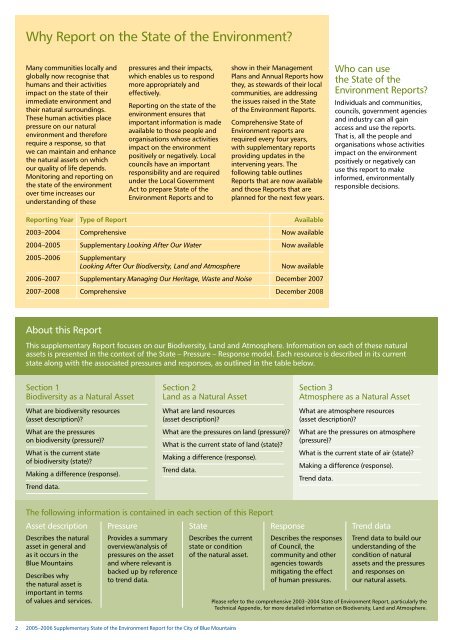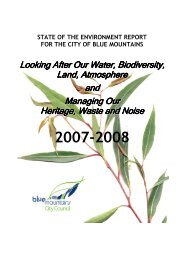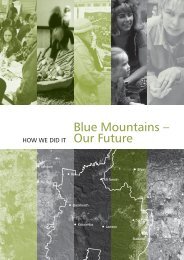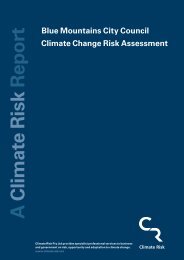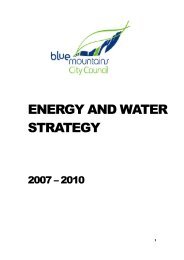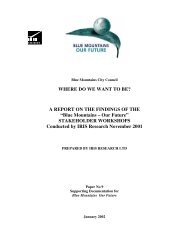State of the Environment Report for the City of Blue Mountains
State of the Environment Report for the City of Blue Mountains
State of the Environment Report for the City of Blue Mountains
Create successful ePaper yourself
Turn your PDF publications into a flip-book with our unique Google optimized e-Paper software.
Why <strong>Report</strong> on <strong>the</strong> <strong>State</strong> <strong>of</strong> <strong>the</strong> <strong>Environment</strong><br />
Many communities locally and<br />
globally now recognise that<br />
humans and <strong>the</strong>ir activities<br />
impact on <strong>the</strong> state <strong>of</strong> <strong>the</strong>ir<br />
immediate environment and<br />
<strong>the</strong>ir natural surroundings.<br />
These human activities place<br />
pressure on our natural<br />
environment and <strong>the</strong>re<strong>for</strong>e<br />
require a response, so that<br />
we can maintain and enhance<br />
<strong>the</strong> natural assets on which<br />
our quality <strong>of</strong> life depends.<br />
Monitoring and reporting on<br />
<strong>the</strong> state <strong>of</strong> <strong>the</strong> environment<br />
over time increases our<br />
understanding <strong>of</strong> <strong>the</strong>se<br />
pressures and <strong>the</strong>ir impacts,<br />
which enables us to respond<br />
more appropriately and<br />
effectively.<br />
<strong>Report</strong>ing on <strong>the</strong> state <strong>of</strong> <strong>the</strong><br />
environment ensures that<br />
important in<strong>for</strong>mation is made<br />
available to those people and<br />
organisations whose activities<br />
impact on <strong>the</strong> environment<br />
positively or negatively. Local<br />
councils have an important<br />
responsibility and are required<br />
under <strong>the</strong> Local Government<br />
Act to prepare <strong>State</strong> <strong>of</strong> <strong>the</strong><br />
<strong>Environment</strong> <strong>Report</strong>s and to<br />
show in <strong>the</strong>ir Management<br />
Plans and Annual <strong>Report</strong>s how<br />
<strong>the</strong>y, as stewards <strong>of</strong> <strong>the</strong>ir local<br />
communities, are addressing<br />
<strong>the</strong> issues raised in <strong>the</strong> <strong>State</strong><br />
<strong>of</strong> <strong>the</strong> <strong>Environment</strong> <strong>Report</strong>s.<br />
Comprehensive <strong>State</strong> <strong>of</strong><br />
<strong>Environment</strong> reports are<br />
required every four years,<br />
with supplementary reports<br />
providing updates in <strong>the</strong><br />
intervening years. The<br />
following table outlines<br />
<strong>Report</strong>s that are now available<br />
and those <strong>Report</strong>s that are<br />
planned <strong>for</strong> <strong>the</strong> next few years.<br />
Who can use<br />
<strong>the</strong> <strong>State</strong> <strong>of</strong> <strong>the</strong><br />
<strong>Environment</strong> <strong>Report</strong>s<br />
Individuals and communities,<br />
councils, government agencies<br />
and industry can all gain<br />
access and use <strong>the</strong> reports.<br />
That is, all <strong>the</strong> people and<br />
organisations whose activities<br />
impact on <strong>the</strong> environment<br />
positively or negatively can<br />
use this report to make<br />
in<strong>for</strong>med, environmentally<br />
responsible decisions.<br />
<strong>Report</strong>ing Year Type <strong>of</strong> <strong>Report</strong><br />
Available<br />
2003–2004 Comprehensive Now available<br />
2004–2005 Supplementary Looking After Our Water Now available<br />
2005–2006 Supplementary<br />
Looking After Our Biodiversity, Land and Atmosphere<br />
Now available<br />
2006–2007 Supplementary Managing Our Heritage, Waste and Noise December 2007<br />
2007–2008 Comprehensive December 2008<br />
About this <strong>Report</strong><br />
This supplementary <strong>Report</strong> focuses on our Biodiversity, Land and Atmosphere. In<strong>for</strong>mation on each <strong>of</strong> <strong>the</strong>se natural<br />
assets is presented in <strong>the</strong> context <strong>of</strong> <strong>the</strong> <strong>State</strong> – Pressure – Response model. Each resource is described in its current<br />
state along with <strong>the</strong> associated pressures and responses, as outlined in <strong>the</strong> table below.<br />
Section 1<br />
Biodiversity as a Natural Asset<br />
What are biodiversity resources<br />
(asset description)<br />
What are <strong>the</strong> pressures<br />
on biodiversity (pressure)<br />
What is <strong>the</strong> current state<br />
<strong>of</strong> biodiversity (state)<br />
Making a difference (response).<br />
Trend data.<br />
Section 2<br />
Land as a Natural Asset<br />
What are land resources<br />
(asset description)<br />
What are <strong>the</strong> pressures on land (pressure)<br />
What is <strong>the</strong> current state <strong>of</strong> land (state)<br />
Making a difference (response).<br />
Trend data.<br />
Section 3<br />
Atmosphere as a Natural Asset<br />
What are atmosphere resources<br />
(asset description)<br />
What are <strong>the</strong> pressures on atmosphere<br />
(pressure)<br />
What is <strong>the</strong> current state <strong>of</strong> air (state)<br />
Making a difference (response).<br />
Trend data.<br />
The following in<strong>for</strong>mation is contained in each section <strong>of</strong> this <strong>Report</strong><br />
Asset description<br />
Describes <strong>the</strong> natural<br />
asset in general and<br />
as it occurs in <strong>the</strong><br />
<strong>Blue</strong> <strong>Mountains</strong><br />
Describes why<br />
<strong>the</strong> natural asset is<br />
important in terms<br />
<strong>of</strong> values and services.<br />
Pressure<br />
Provides a summary<br />
overview/analysis <strong>of</strong><br />
pressures on <strong>the</strong> asset<br />
and where relevant is<br />
backed up by reference<br />
to trend data.<br />
<strong>State</strong><br />
Describes <strong>the</strong> current<br />
state or condition<br />
<strong>of</strong> <strong>the</strong> natural asset.<br />
Response<br />
Describes <strong>the</strong> responses<br />
<strong>of</strong> Council, <strong>the</strong><br />
community and o<strong>the</strong>r<br />
agencies towards<br />
mitigating <strong>the</strong> effect<br />
<strong>of</strong> human pressures.<br />
Trend data<br />
Trend data to build our<br />
understanding <strong>of</strong> <strong>the</strong><br />
condition <strong>of</strong> natural<br />
assets and <strong>the</strong> pressures<br />
and responses on<br />
our natural assets.<br />
Please refer to <strong>the</strong> comprehensive 2003–2004 <strong>State</strong> <strong>of</strong> <strong>Environment</strong> <strong>Report</strong>, particularly <strong>the</strong><br />
Technical Appendix, <strong>for</strong> more detailed in<strong>for</strong>mation on Biodiversity, Land and Atmosphere.<br />
<br />
2005–2006 Supplementary <strong>State</strong> <strong>of</strong> <strong>the</strong> <strong>Environment</strong> <strong>Report</strong> <strong>for</strong> <strong>the</strong> <strong>City</strong> <strong>of</strong> <strong>Blue</strong> <strong>Mountains</strong>


